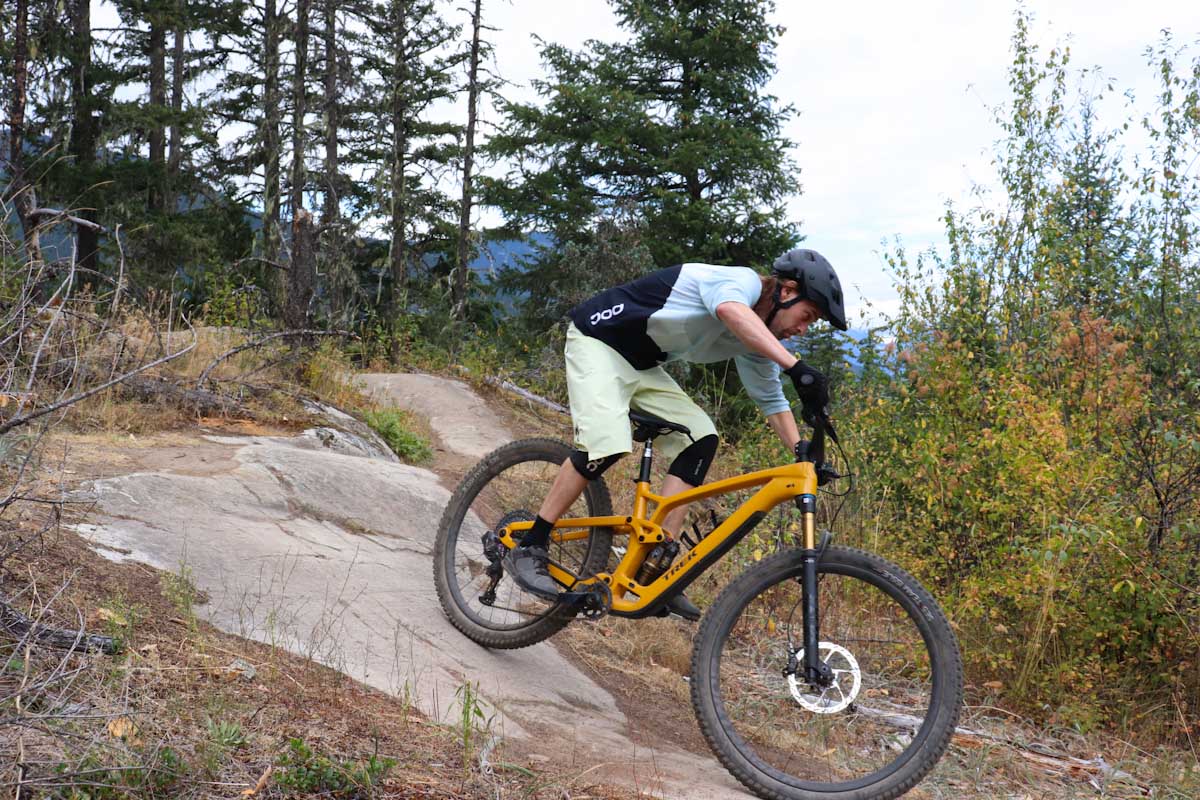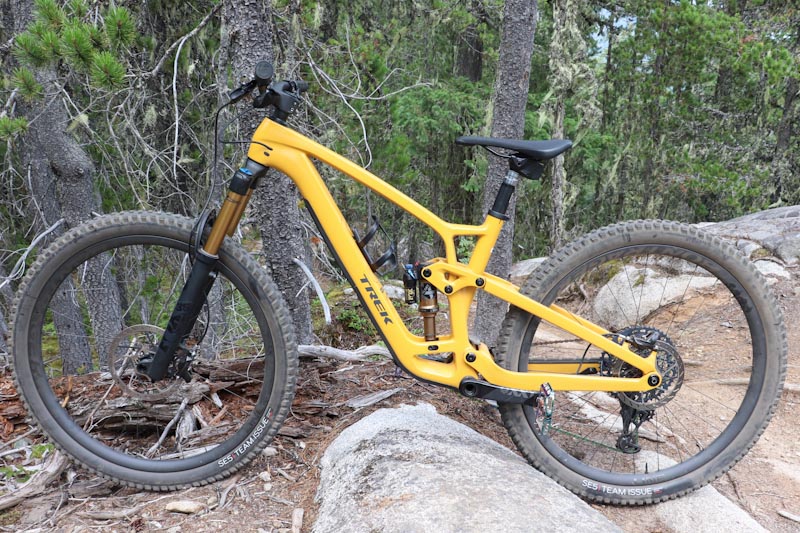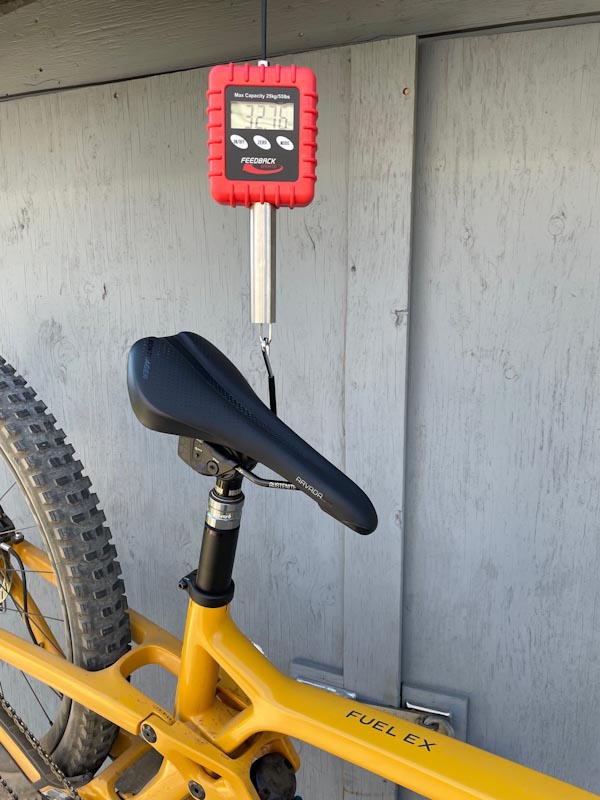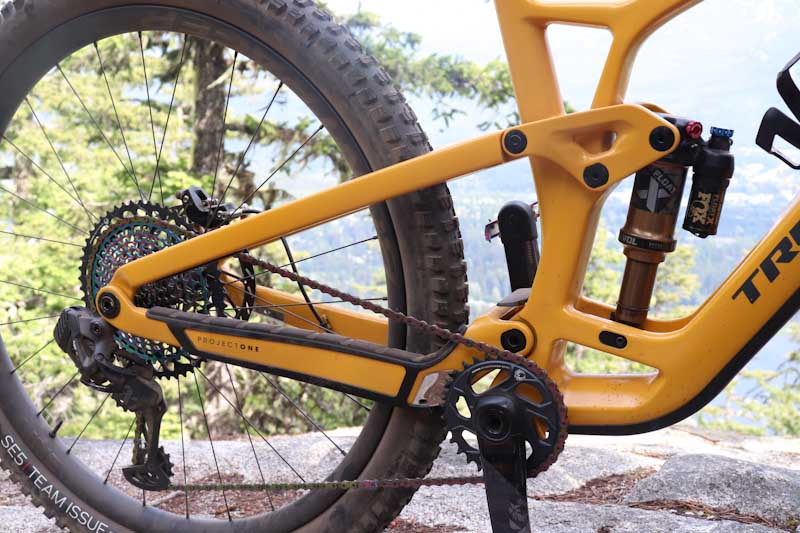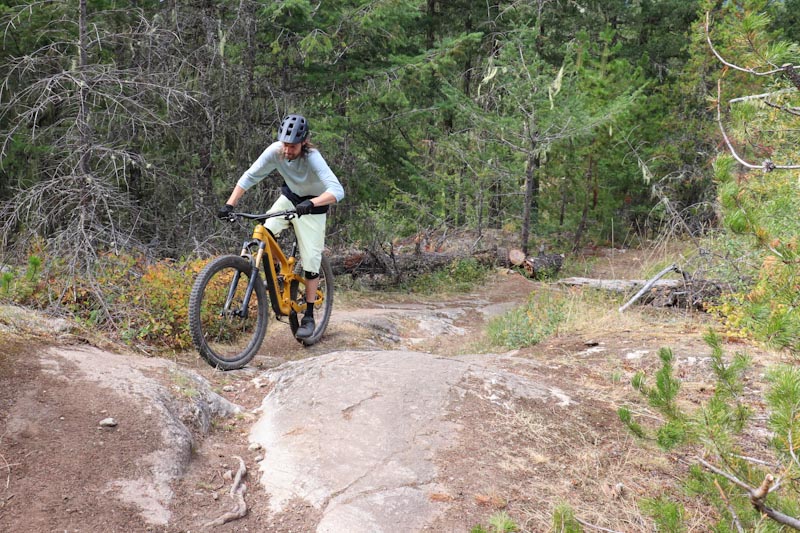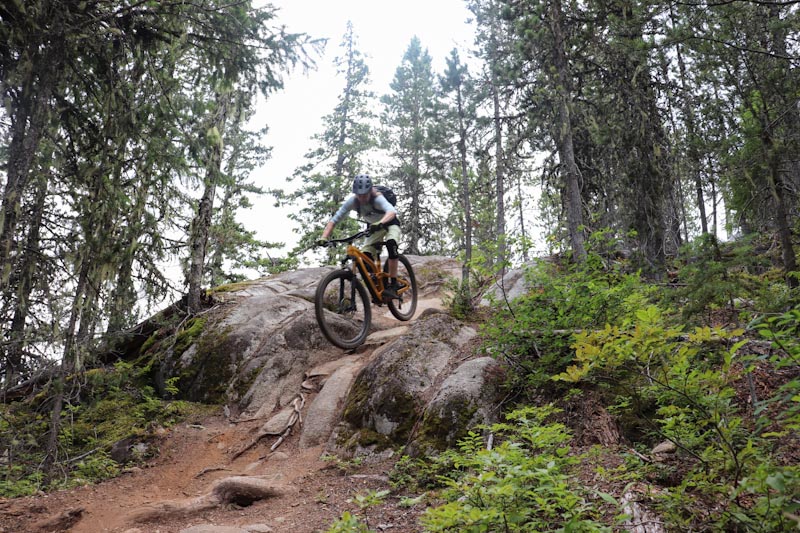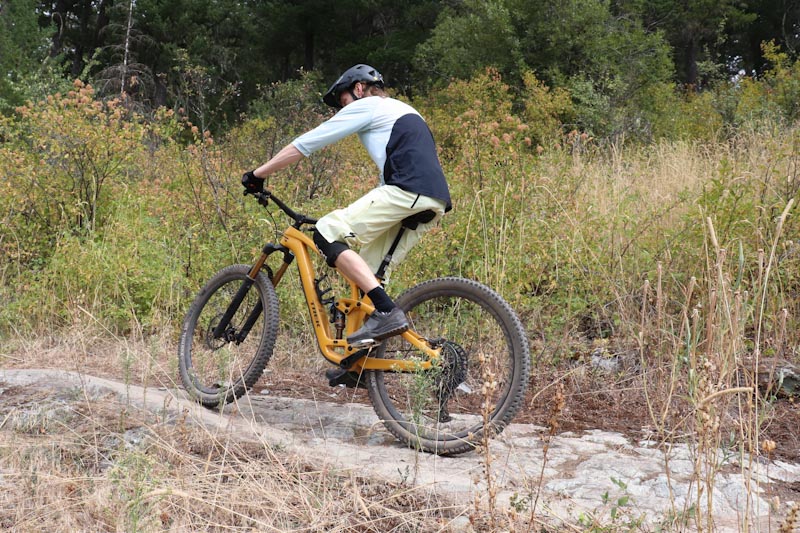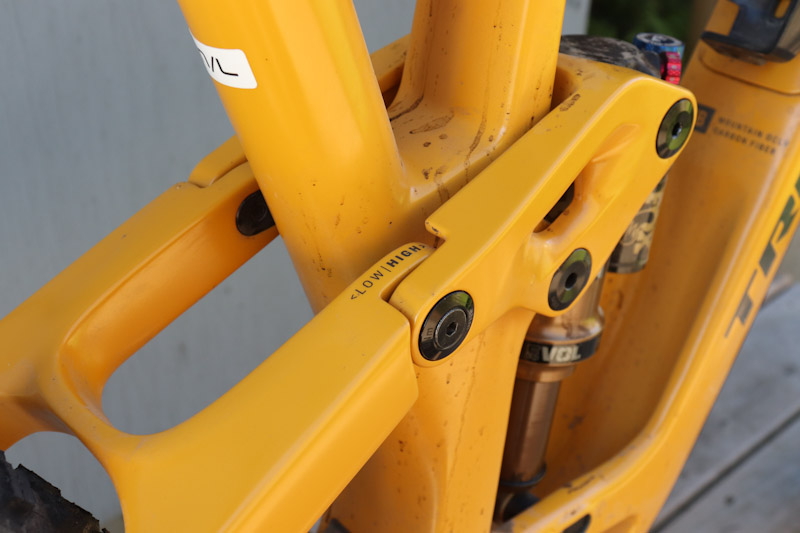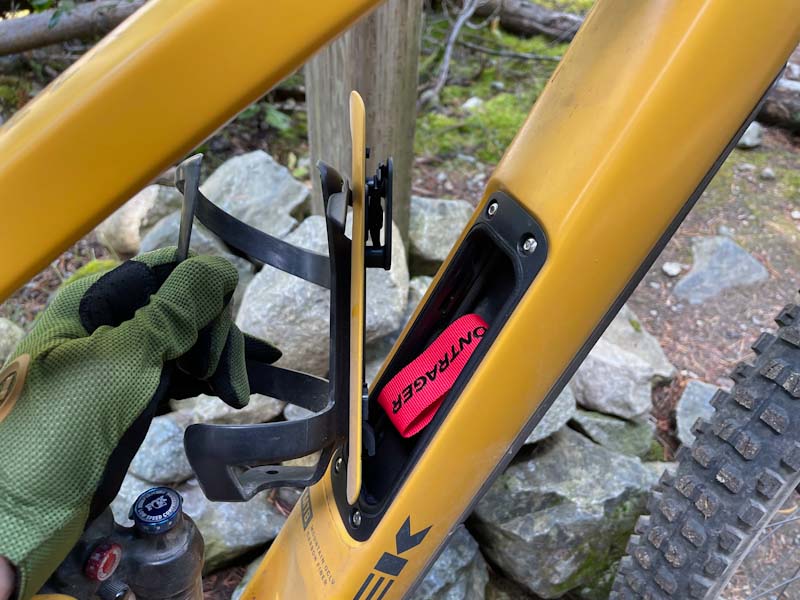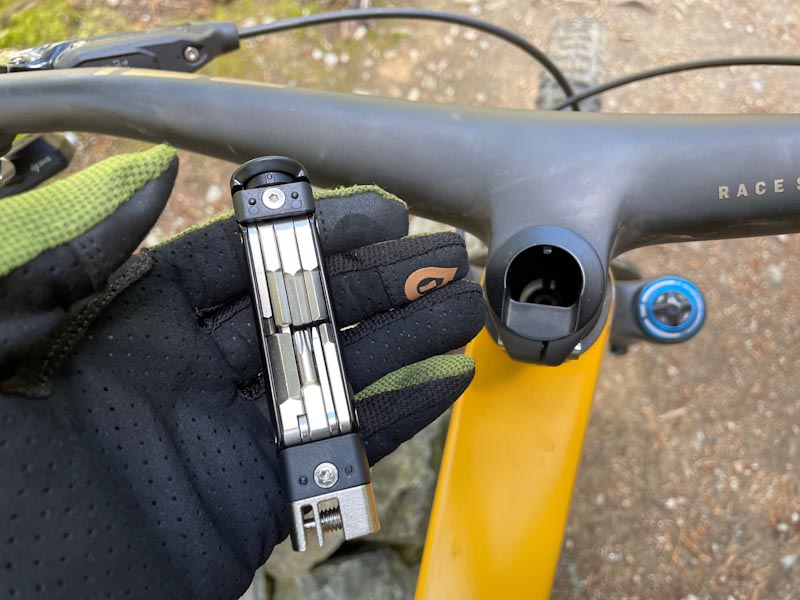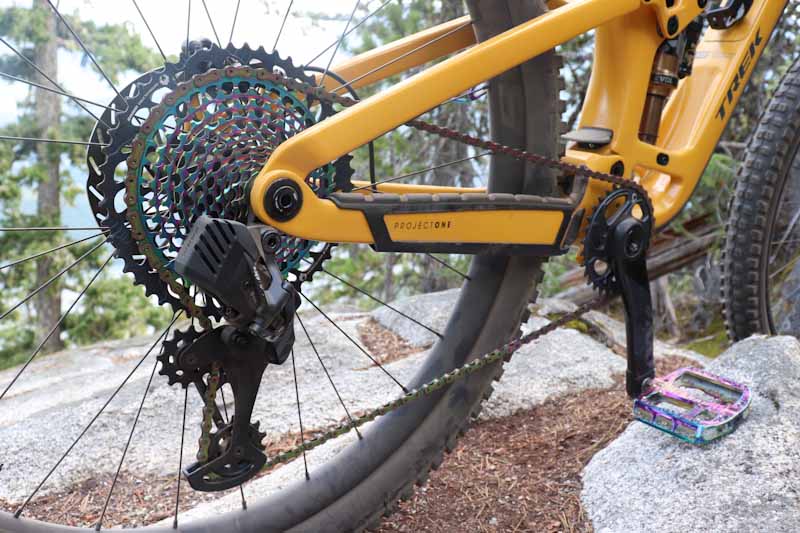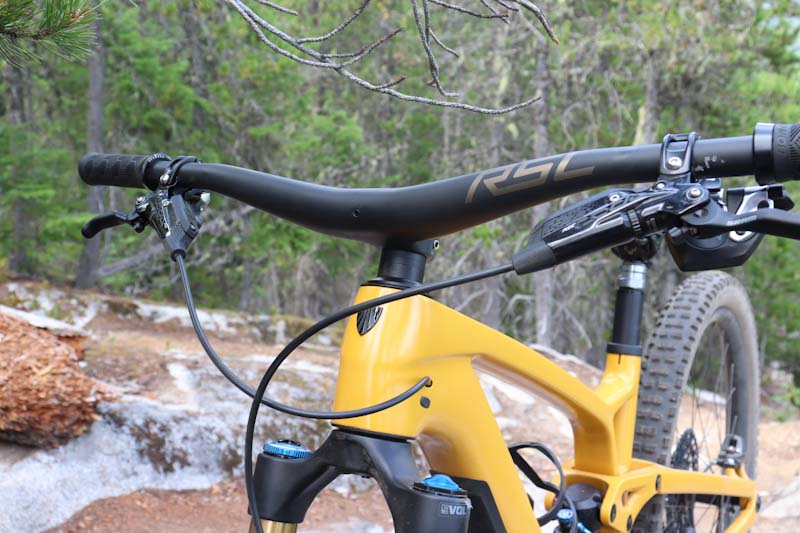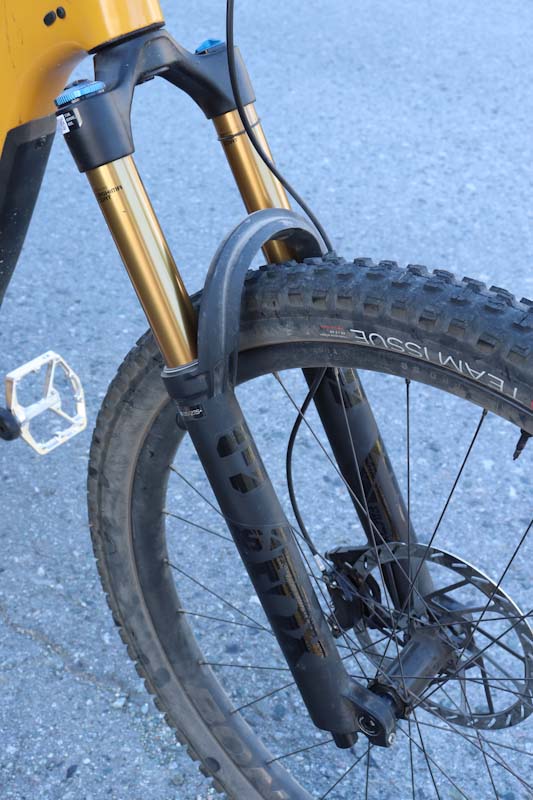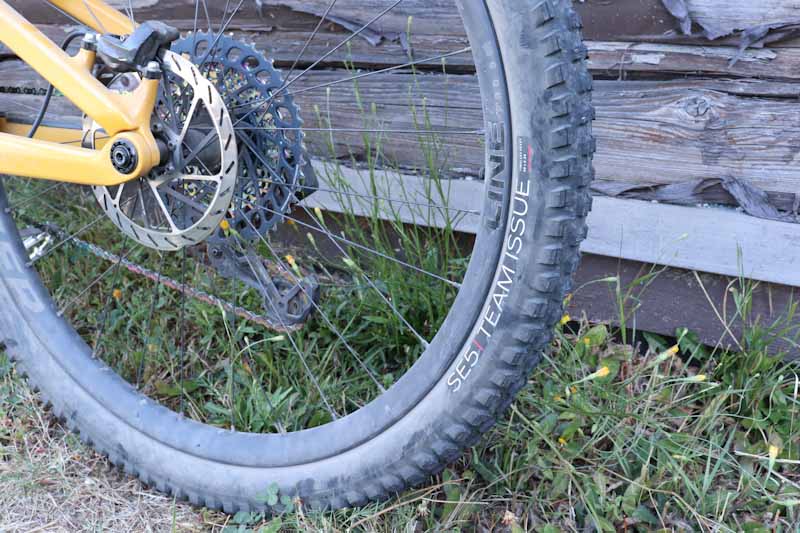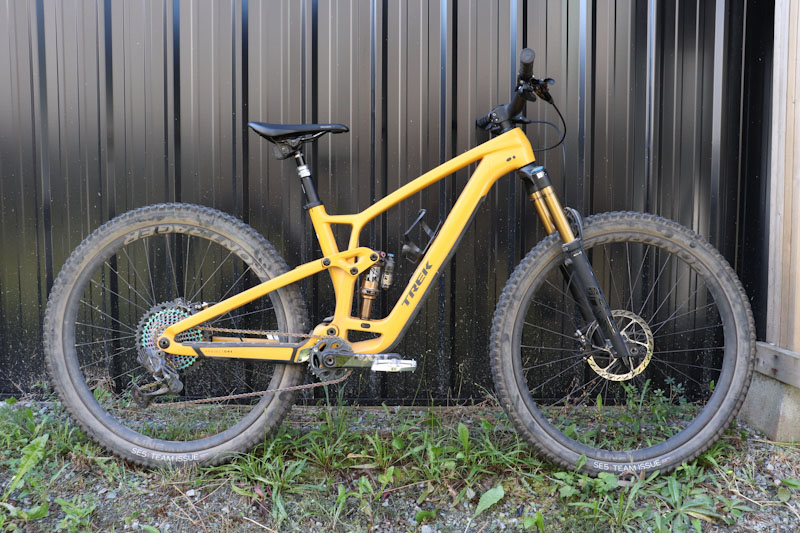I’ll admit, climbing is not my favourite part of a ride, but when you get a bike that climbs like Trek’s new Fuel EX, cranking uphill gets a lot more enjoyable! The 2023 Fuel EX will serve as Trek’s mid-travel do-everything trail bike, and it offers a near perfect ‘quiver-killer’ package with its aggressive climbing ability, slack steering angle and 140/150mm travel. Add adjustable geometry and shock progressivity to that, and you’ve got one versatile trail machine.
I picked up the Fuel EX 9.9 XX1 AXS during Crankworx Whistler, giving me a few weeks to get a handful of rides on it. Right away I can say the bike climbs like a hyperactive goat, but my area demands a bike that can descend well too. The Fuel EXs steering angle is slack enough for any trail, so the bike only finds its limit on really rough terrain that challenges its 140mms of rear travel.
2023 Trek Fuel EX – basic specs:
In this article we’ll discuss how the new Fuel EX rides. Here’s few basic specs, but check out my launch post for all the details on the new Fuel EX’s features, geometry and build kit options.
The Fuel EX frames are offered in both aluminum or carbon, with 140mm rear travel and a 150mm fork (except the entry level EX 5 which carries over the outgoing frame with 130mm travel). Most sizes ride on 29” wheels, but the XS frames run 27.5” only and the smalls offer the option of 27.5” or 29”. The 29ers can be converted to mullet setups, but Trek recommends adding a 160mm fork.

Between Trek’s Mino Link chip and optional angle adjust headset cups for the Fuel EX, there’s plenty of variation in frame geometry depending on settings. Some angles and measurements change with frame size as well, particularly the rear end lengths which are now size-specific.
To summarize it quickly, the Fuel EX’s head tube angle can range from 63.5° to 66° with the optional cups in play. Without the cups, the Mino Link gives you the choice of 64.5 or 65°. Seat masts are pretty steep at 76 to 78.9° across all sizes/settings.
Trek stretched out some pretty lengthy reaches on the Fuel EXs; The M/L bike I’m testing measures 470mm. Out back, Trek leaned towards the middle with their new size-specific chainstay lengths. The M/L frame I rode has 440mm stays, which are not short but not long either.
The top-of-the-line Fuel EX 9.9 XX1 AXS weighs 32.76lbs (with pedals).
Ride Impressions: Suspension
I am quite familiar with Trek’s suspension, as I’ve owned a Remedy for the last few years. I wasn’t surprised to find the Fuel EX climbs even better, and offers about 95% of the Remedy’s downhill prowess.
Trek’s ABP linkage is a very supportive climber, especially with the rear shock in its firm position. With the shock’s help, the rear end firms up enough that the rear wheel starts floating over pockets between roots and rocks, rather than diving into them. You’ll still use about 50% of the rear travel on singletrack trails in firm mode, so I still find traction is ample and the ride remains fairly comfortable.
What’s great is how the Fuel EX is a solid climber without any help from the shock too. Climbing technical singletrack in open mode, I only dipped into 2-3mms more travel than climbing in firm mode. The ride does get a bit more forgiving and slightly more grippy in open mode (without losing much efficiency), so it’s a practical option for rougher ascents.
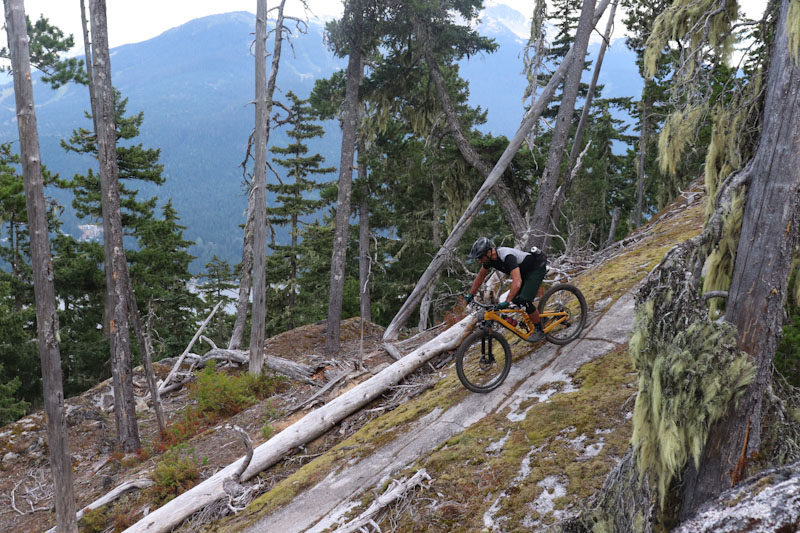
Somehow, despite how supportive the Fuel EX’s ABP linkage is going uphill, it’s a whole different beast going down. It’s as if the linkage is speed-sensitive, as it responds very well to all kinds of high-speed impacts and has an impressive ability to round off sharp hits. Whether it’s small chatter or a full-on rock garden, the Fuel EX smooths out the trail very nicely. The rear wheel always feels well planted, and the linkage gives the bike a plowy feel through rough terrain. I do find Trek’s bikes aren’t super poppy on jumps, but they do have ample mid-stroke support to pump well through rollers and berms.
I have some delightfully rough trails in my area of B.C. and I did find moments where more than 140mm travel would have been ideal! That said, I don’t think you could do much better with 140mms of suspension than the Fuel EX has. While it’s really the slack steering that allows this bike to tackle pretty serious terrain, the adjustable shock rate also raises this bike’s tolerance for fast, rough riding.
I had no trouble getting full travel from the bike in its more linear LESS mode, and being a lightweight rider this is the mode I’d keep the bike in. It was perfectly dialed – I was enjoying full travel on descents but not frequently thrashing the bike with harsh bottom-outs.
When I flipped the chip into MORE mode, it did make a noticeable difference to the ride, but didn’t have much effect on how much travel I was using. I expected the bike to feel stiffer than preferred and that I’d need a good hard hit to bottom out the bike with the added progression. Instead I wound up using all the bike’s travel on any typical descent, although there was a palpable difference in how the bike felt. I could tell the linkage was resisting hard, fast impacts more than before, so I’d bet fans of coil shocks, or heavier and more aggressive riders would appreciate the difference the chip makes. In my case, it just made the ride a bit firmer than it needed to be. If I was a competitive racer I’d probably prefer MORE mode, but I ride recreationally so I keep things on the soft side!
Geometry:
Fit-wise, the first thing I noticed about the Fuel EX is its generous reach. At 470mm on the M/L frame, it’s about the longest bike I’ve ridden yet. This nearly straightens my arms, so I don’t think I’d want to go any longer, but it did feel roomy and comfortable on the trails. Of course the steep 77.5 degree seat mast leans you over that lengthy front end, so you wind up well centered between the wheels.
I liked the 440mm chainstay length on the M/L Fuel EX. It’s not so long that the bike feels like an enduro sled, but it is long enough to provide a stable ride and great climbing traction on steep uphill sections.
I am also a fan of slack steering angles. I didn’t have the optional headset cups for the Fuel EX so I couldn’t go to 63.5°, but my demo bike was set up at 64.5°. That’s a great number for rowdy trails, and definitely allows this mid-travel bike to take on enduro-level terrain. I have not found running a slack steering angle causes any real penalty on climbs, so I’m happy with a slack trail bike.
The Fuel EX comes with the Mino link in Low position, which is definitely the preferred setting for my local terrain. The BB does ride pretty low in this position at 335mm, but I must be getting used to low BB’s because I didn’t have any problem with pedal strikes on this bike.
Standover height on the Fuel EX is not particularly low, but not problematic for me. If I wound up near the head tube I could damage some sensitive bits, but in front of the saddle there’s ample clearance for standing comfortably.
On-Bike Tools and Storage:
In recent years, Trek has jumped on board with on-bike storage and tools. The Fuel EX, in either aluminum or carbon, offers a frame storage compartment in the down tube. The included Bontrager BITS tool roll is designed to hold a tube, co2 canisters, an inflator head and tire levers.
The high-end Fuel EX 9.9s also come with tools in the steerer tube. The Bontrager tool offers a chainbreaker, and a removable multi-tool with seven allen keys, a torx and a flathead screwdriver bit.
Components:
The Fuel EX 9.9 XX1 AXS boasts a pretty top-of-the-line build kit, and gave me my first experience with SRAM’s AXS electronic drivetrain. I really like the feel and ergonomics of SRAM’s dropper post and shifter remotes, as the light push-button action is undeniably easier than throwing paddles on a traditional cable shifter. Performance-wise, the AXS drivetrain was great but not perfect – about once on every ride I’d get a bit of a hesitation when shifting (not always the same gear), and once the derailleur harshly jumped back into a gear after I rode a rough downhill section. Otherwise, the shifting was quick and precise, so for my short test I didn’t attempt to reconfigure the shifting. I had no real mechanical issues with any of the AXS components on my rides.
Aside from the XX1 AXS drivetrain I’d say it’s the one-piece handlebar/stem that gives the top-tier Fuel EX a really high performance look. The Bontrager RSL bar/stem offers a 27.5mm rise, 820mm stock width, and a 45mm stem length with zero rise.
SRAM’s Code RSC brakes offered ample power for any descent, but I was a bit surprised to feel how much squeeze they required to get full braking force. Of course, their modulation is great but compared to the TRP DH-R EVO’s I’ve been riding the Code RSC’s required more effort to almost lock up a wheel.
When I picked up the Fuel EX Trek’s people had it all set up for me, and I didn’t have to touch any adjustments on the fork or rear shock throughout my testing. Not surprisingly, the top-notch Fox Factory 36 EVOL fork with its Grip 2 damper left me nothing to complain about, as did the Fox Factory Float X rear shock.
Bontrager’s Line Pro 30 carbon wheelset offered that pleasant, slightly damped feeling carbon rims can provide, and survived my testing with no damage to speak of. The Bontrager SE5 Team Issue tires don’t match Maxxis’ Minions or Assegais in terms of overall grip, but they’re still fairly good for traction and they’re a fast rolling tire. To make sure you can get those wheels moving over anything, the Fuel EX 9.9 XX1 AXS comes with a small 30t front chainring and a 10-52t rear cassette.
I had no comfort issues with the Bontrager Arvada saddle, and no other mechanical concerns with any other components.
I’ve described how well the Trek is set up for all-around trail riding, but one thing I really appreciate is the relatively low weight of the Fuel EX 9.9 XX1 AXS. I’m a small guy, so I find lighter bikes a pleasure to climb, as they’re easy to heave up over bumps and power up steep sections. I’d bet Trek could have gone even lighter, but probably not with all the functionality plus the bells and whistles this bike includes.
The Fuel EX 9.9 XX1 AXS retails for $10,749.99.
Want more tech info on the new Trek Fuel EX? Check out our in-depth post here.
